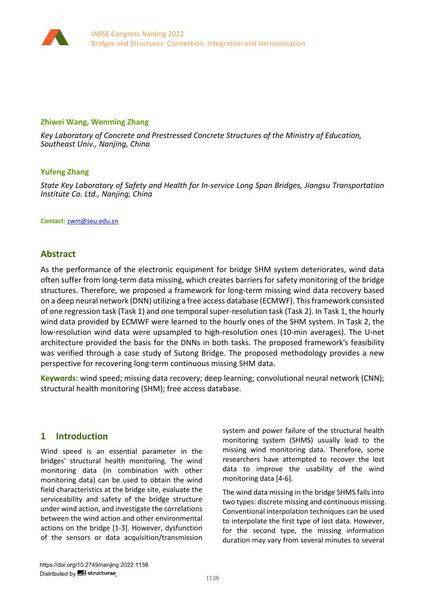Long-term Missing Wind Data Recovery for Bridge Health Monitoring Using Deep Learning

|
|
|||||||||||
Bibliografische Angaben
| Autor(en): |
Zhiwei Wang
(Key Laboratory of Concrete and Prestressed Concrete Structures of the Ministry of Education, Southeast Univ., Nanjing, China)
Wenming Zhang (Key Laboratory of Concrete and Prestressed Concrete Structures of the Ministry of Education, Southeast Univ., Nanjing, China) Yufeng Zhang (State Key Laboratory of Safety and Health for In-service Long Span Bridges, Jiangsu Transportation Institute Co. Ltd., Nanjing, China) |
||||
|---|---|---|---|---|---|
| Medium: | Tagungsbeitrag | ||||
| Sprache(n): | Englisch | ||||
| Tagung: | IABSE Congress: Bridges and Structures: Connection, Integration and Harmonisation, Nanjing, People's Republic of China, 21-23 September 2022 | ||||
| Veröffentlicht in: | IABSE Congress Nanjing 2022 | ||||
|
|||||
| Seite(n): | 1138-1146 | ||||
| Anzahl der Seiten (im PDF): | 9 | ||||
| DOI: | 10.2749/nanjing.2022.1138 | ||||
| Abstrakt: |
As the performance of the electronic equipment for bridge SHM system deteriorates, wind data often suffer from long-term data missing, which creates barriers for safety monitoring of the bridge structures. Therefore, we proposed a framework for long-term missing wind data recovery based on a deep neural network (DNN) utilizing a free access database (ECMWF). This framework consisted of one regression task (Task 1) and one temporal super-resolution task (Task 2). In Task 1, the hourly wind data provided by ECMWF were learned to the hourly ones of the SHM system. In Task 2, the low-resolution wind data were upsampled to high-resolution ones (10-min averages). The U-net architecture provided the basis for the DNNs in both tasks. The proposed framework's feasibility was verified through a case study of Sutong Bridge. The proposed methodology provides a new perspective for recovering long-term continuous missing SHM data. |
||||
| Copyright: | © 2022 International Association for Bridge and Structural Engineering (IABSE) | ||||
| Lizenz: | Die Urheberrechte (Copyright) für dieses Werk sind rechtlich geschützt. Es darf nicht ohne die Zustimmung des Autors/der Autorin oder Rechteinhabers/-in weiter benutzt werden. |
||||
